
Are you confused about how to find the right under sink water filter? The deeper you investigate these filters, the harder it is to choose one. Stay with us, we analysed all models: with tank or tankless, filtration technology: activated carbon, ion exchange, or reverse osmosis, smart technologies, and all you need to know about this type of water purifier. There are certain criteria that users must consider to make a wise choice. Reading this buying guideline will guide you through the realm of undersink water filters and give you everything you need.
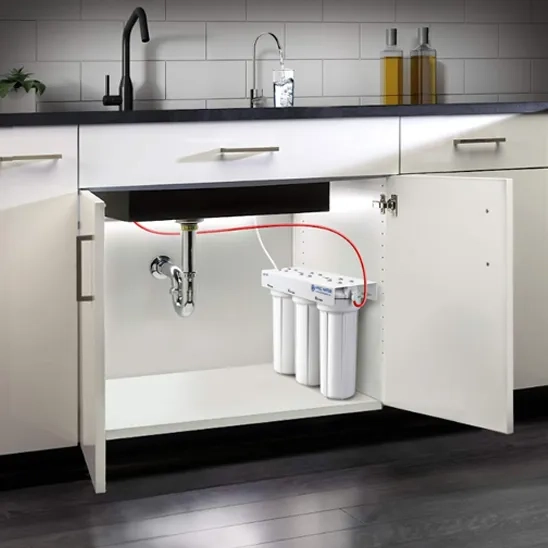
1. Key Considerations When Choosing Under Sink Water Filters
Under sink water filters are an eco-friendly solution for homeowners looking to improve the quality of their drinking water. While they offer significant benefits, it’s important to consider several crucial factors to make the best choice. Key elements to consider include the purpose and application of the filter, the types of contaminants in your water, the filtration technology used, and the filter’s certification. A detailed buying guide can help you navigate these factors effectively. Here’s a breakdown of some important considerations that will assist you in selecting the right under-sink water filter for your needs, based on a comprehensive buying guide. By evaluating these aspects, you’ll be able to make an informed decision and ensure the filter meets your requirements for clean, safe water.
1.1. Purpose and Application
The first and foremost step in purchasing an undersink water filter is determining your goal and application. Under sink water filters are designed to improve the quality, taste and odor by eliminating the range of contamination such as heavy metals, bacteria and chloride. These products are extremely useful for households that do not want to use bottle water and need clean tap water. The main goal of the under sink water filters is to provide safe water for your family. Not only can they remove chloride, which affects the odor and taste of the water, but they can also eliminate things like lead and mercury. Some advanced models offer pesticides, which can be induced to water by agricultural runoff. Clean water is necessary for washing fruits and vegetables, which under a sink water filter can produce it while they are environmentally friendly and reduce the carbon footprint. In addition to the use of under sink water filters for drinking, these products can be used for aquariums, hydroponic systems, and humidifiers. They can provide high-quality water for your fish, which are sensitive to the water quality or humidifier components that are sensitive to the water quality and using regular water can cause corrosion to them.
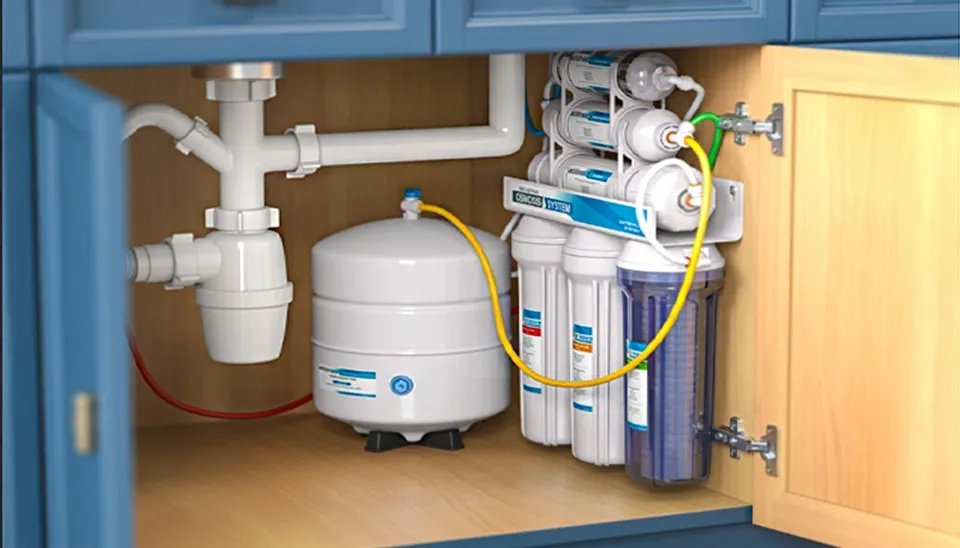
1.2. Filter Type and Technology
Contaminants you want to remove can determine the under sink water filter you should buy since different products offer different filtration and technology that is suitable for some specific contamination, which will be discussed in this section of the buying guide.
1.2.1. Activated Carbon Filters
Activated carbon filters are the most prevalent type of filter among under sink water filters, removing contaminants by absorbing them to the surface of activated carbon material. This filter can successfully remove chlorine, which can be found in water taps sourced from water treatment plants. This can enhance the overall quality of the drinking water as well as improve the taste and odor of the water, resulting in a more pleasant water for drinking. This filter can also remove some metal contamination such as lead, mercury, and copper, but it is not as efficient as other filters that are designed for this goal. Activated carbon filters are also effective in removing chemicals, such as pesticides, herbicides, and volatile organic compounds. These filters are widely used and cost-effective, but their performance is limited. These filters are not efficient for microorganisms or nitrate removal; their lifespan is limited, requiring replacement regularly.
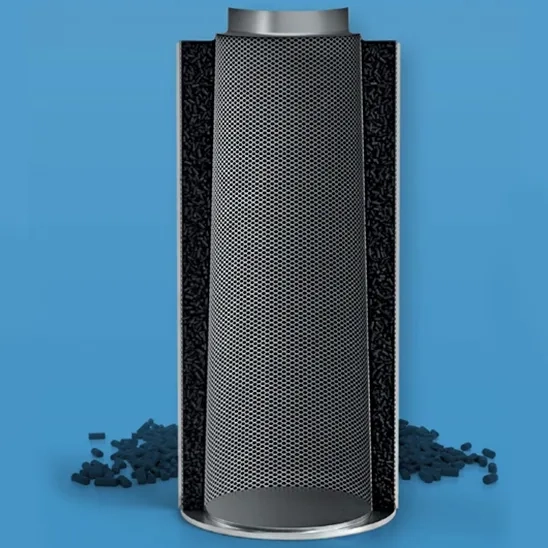
1.1.2. Ion Exchange Filters
Ion exchange systems are used for effective elimination of dissolved ions from water. Ion exchangers swap one ion for another, hold it temporarily, and subsequently release it to a regenerant solution. In an ion exchange system, unwanted ions in the water supply are replaced with more acceptable ions. These filters can effectively eliminate heavy metal contamination, including lead and copper. The filtration process involves several steps: initially the charged particles pass through resin, then cations generally exchange with sodium or hydrogen, while aniones exchange with chloride or hydroxide. These filters, by eliminating calcium and magnesium, can change the water from hard to soft, offsetting the impacts of calcium in human health. Ion exchange reduces fluorides, and the alkaline filter enriches your tap water with beneficial minerals and improves taste, offering pure, healthy water. Moreover, ion exchange filters are able to regenerate by salt solution, decreasing the cost of replacing them. Similar to activated carbon filters, ion exchange filters can not remove microorganisms or organic contaminants. Also, those filters that use sodium ions in the exchange process might induce elevated sodium in the water.
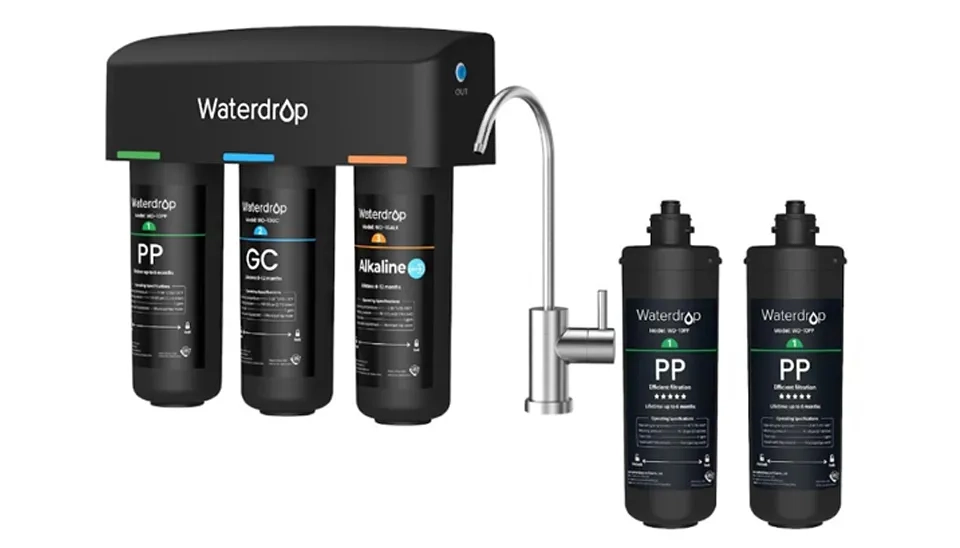
1.1.3. Sediment Filters
Sediment filters are sophisticated filters, blocking contaminants based on their size when passing through fibers with porous walls. These filters are useful for eliminating suspended particles like bacteria or protozoa. Based on the pore size of the filter, the process works either with microfiltration or ultrafiltration. A benefit of these filters is that they work with no chemicals and are entirely mechanical. Also, the filtration process is rapid in comparison to other filters. However, Sediment filters do not have the ability to remove dissolved contaminants and their performance can be limited by clogging if there is a high amount of sediment and suspended particles in the water.
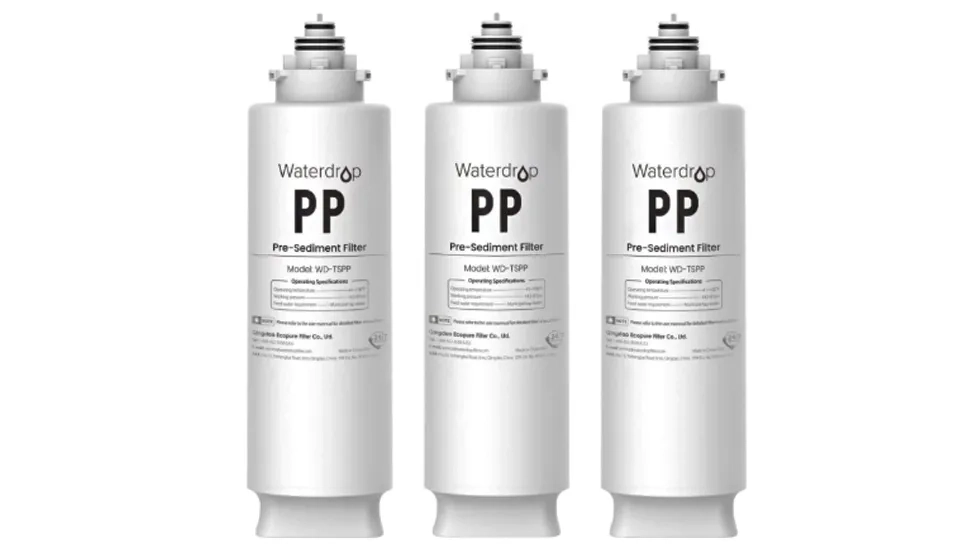
1.1.4. Reverse Osmosis
The reverse osmosis (RO) water filtration process is a widely recognized and highly effective method for purifying water, known for its straightforward yet efficient mechanism. In this process, water is forced through a semipermeable membrane designed to block contaminants while allowing clean water molecules to pass through. This membrane is engineered with extremely fine pores, which effectively eliminate a broad range of impurities such as chemicals, heavy metals, sediments, and dissolved solids. As a result, reverse osmosis is particularly effective in improving water quality by removing pollutants that may affect taste, odor, and overall safety. One of the key strengths of reverse osmosis is its ability to tackle various forms of contamination, including harmful substances like lead, arsenic, fluoride, and nitrates. This comprehensive filtration makes RO systems ideal for households seeking cleaner and safer drinking water. However, the purification process is relatively slow compared to some other filtration methods, as water must be pushed through the membrane at a controlled pace to achieve optimal results.
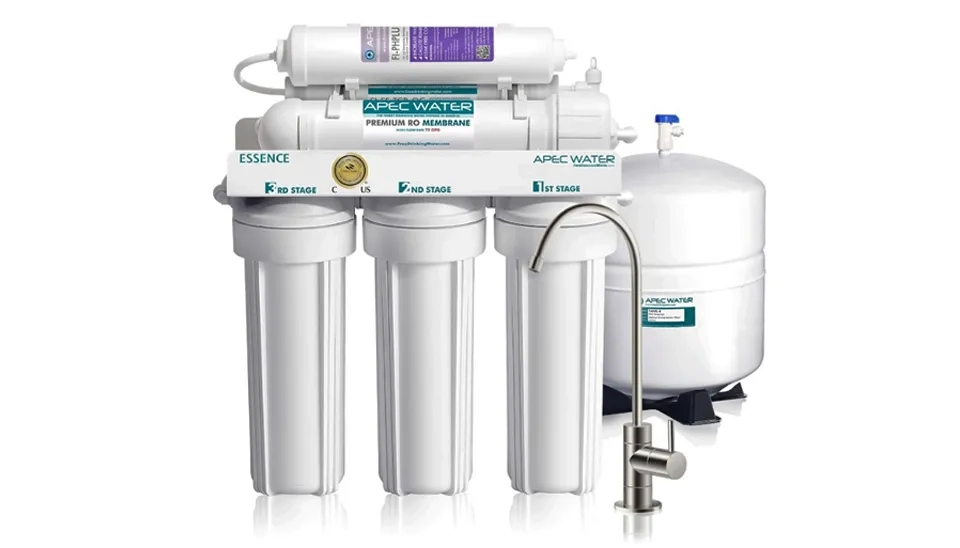
1.1.5. Combination Filters
Usually under sink water filters include separate stages with different filters to ensure contaminants removal. At the first stage, micron filters remove dirt, debris, and even microscopic particles from water. A 5-micron filter, for example, removes particles as small as 5 microns. Anything smaller passes through the pores. Sediment filters are the most common type of micron filter. At the second stage, activated carbon filters are generally employed in the process of removing organic compounds and/or extracting free chlorine from water, thereby making the water suitable for discharge or use in manufacturing processes. Eliminating organics in potable water, such as humic and fulvic acid, prevents chlorine in the water from chemically reacting with the acids and forming trihalomethanes, a class of known carcinogens. An ultrafiltration filter has a pore size around 0.01 micron. In another stage, ultrafiltration is utilized, microfiltration filters have a pore size around 0.1 micron, so when water undergoes microfiltration, many microorganisms are removed, but viruses remain in the water. Ultrafiltration would remove these larger particles and may remove some viruses. However, these stages can be varied in different filtration systems. For instance, in an undersink water filter with reverse osmosis, the filter cartridge, also known as a PP cotton filter cartridge (PPF), is the first phase, followed by the granular activated carbon (UDF) filter cartridge, the precision compressed activated carbon (CTO) filter cartridge, and finally the reverse osmosis membrane or ultrafiltration..
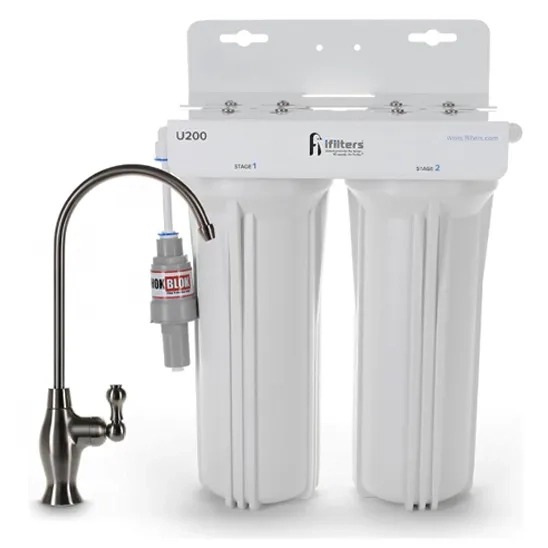
1.2. Filtration Rate
Filtration rate is the amount of fluid that can flow through the surface area of the filter media within a given amount of time, usually described in Gallons or Liters per Minute Standard under sink water filters have a flow rate of 0.5 to 2 GPM, while, as mentioned, reverse osmosis filters have a lower filtration rate of about 0.3 to 0.8. For example, Aquasana SmartFlow has 0.8 GPM filtration rate, while Aquasana Under Sink Water Filter System has 0.5 GPM. In addition to the type of filters that affect the filtration rate, the surface area and size of the filtration are important because a bigger filtration passes through more water. Moreover, water pressure can affect the filtration rate; higher water pressure means more water can pass through the filters.
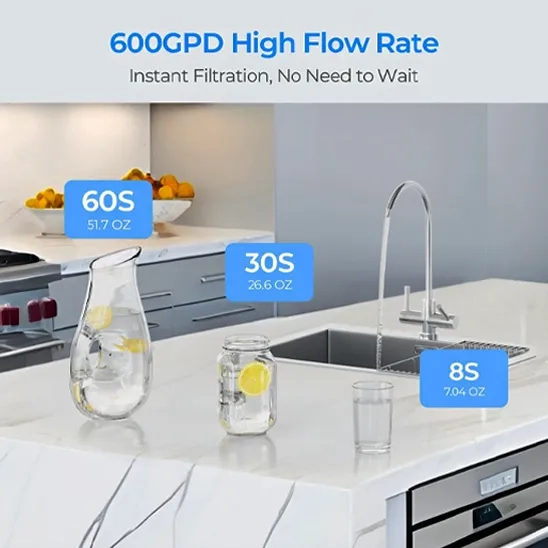
1.3. Smart Sensors and Indicators
Some new advanced under sink water filters come with smart sensors and indicators. This is an emerging technology that increases the user experience, functionality and performance. These sensors can collect and show various real-time data about water quality. A major concern of the customers of the under sink water filters is that when they must replace the filters to maintain their water quality, new and advanced filters can track the filter’s life and alarms when the replacing is needed, rectifying users worry about changing filters on time. These filters can help in the process of maintenance by showing the flow rate when users utilize the filters. This can help users identify problems like clogging. Some of the advanced filters can link to mobile devices with an app to help users to keep track of the filter's health or water quality. With smart filters, users can define the filtration process and if they are worried about certain contaminants, they can change the setup to concentrate more on the specific contaminants.
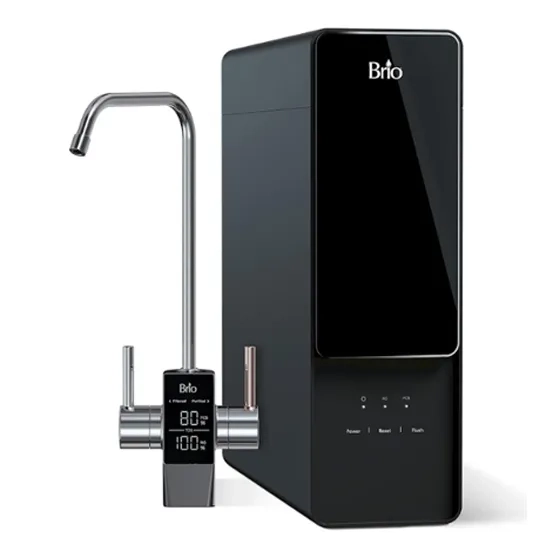
1.4. Type
There are two main types of under-sink water filters: tank and tankless systems, each with a different advantage. Tank systems, such as the SimPure T1-400UV, incorporate a separate tank that stores the filtered water and allows for a constant supply of filtered water at all times even during peak use. This choice is ideal for households with huge water needs but takes up additional space under the sink. On the other hand, tankless units, like the iSpring RO500AK, filter water directly without a storage tank. Tankless units are compact, providing an unbroken stream of fresh filtered water but experience a mild delay in delivering water during peak usage. Both offer better filtration performance, differing in space and usage needs.
Under sink water filters come with a variety of designs to meet different kitchen layouts. While under your sink might have limited space, it is essential to find the filters that are compatible with your space. Also, different filters need a variety of spaces; for example, those with reverse osmosis need reverse osmosis membranes, which require extra space allocation. Moreover, another element that can affect the space is the stage of filtration. Filters with one-stage filtration have a compact design, while those with multi-stage filtration have a pre-filter and other items. Some advanced under sink water filters integrates storage tanks to minimize the space need.
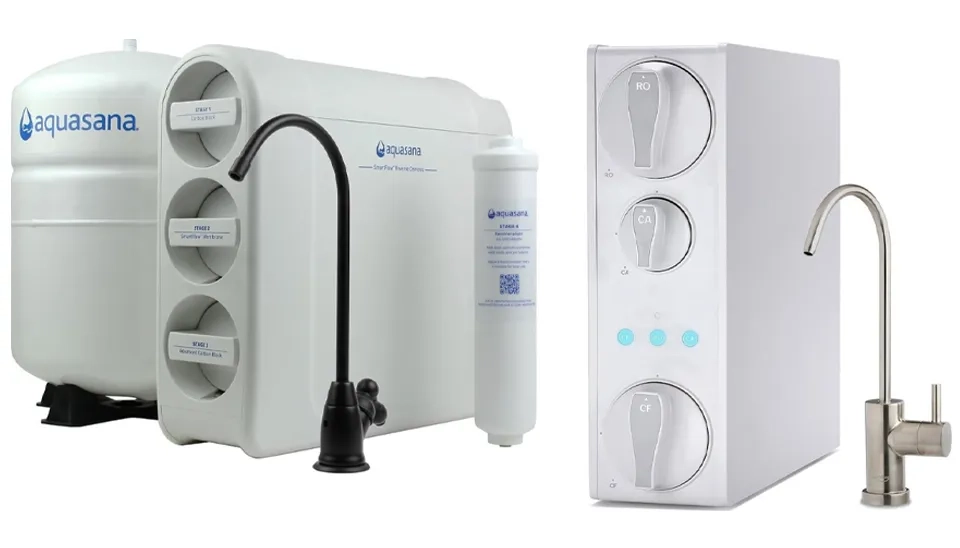
1.5. Filter Lifespan
Like any other device, under sink filters have a specific life span, which is described as Gallons . Each filter type has a different life span; for example, hollow fiber membrane filters have a higher life span than activated carbon filters and ion exchange filters. There are some factors that can influence the life span. Firstly, usage can affect how long a filter lasts, and heavy usage may cause a filter to exceed its capacity before the recommended replacement time. Another element is the amount of contamination in the water that you use the filters on. If the water includes a high amount of contamination, more filters need to be done. This can minimize the under sink filters’ lifespan.

1.6. Installation and Maintenance
One important element when it comes to the under sink water filters is installation and maintenance, which will be evaluated in this section of the buying guide. The installation process varies significantly based on the filters’ types. Some filters offer DIY (Do It Yourself) installation with easy installation for users to follow. Some filters, like reverse osmosis, might have a more demanding installation including connecting additional lines for wastewater. If you are not familiar with the process of installation, it is advisable to use experts because the whole functionality of the undersink water filters depends on suitable installation. It is essential to evaluate your space before purchasing under sink water filters. While many filters need low space due to their compact design, others might need more space for their storage tanks or waste disposal lines. If you have little space, consider tankless under sink water filters with a compact design. In some cases, you might need to replace the other items to make space for filtration systems. The main maintenance of the under sink water filters is replacing the filters, which depends on the filters’ type. Periodic checks for any leakage or clinging is advisable to make sure filters have their highest performance.
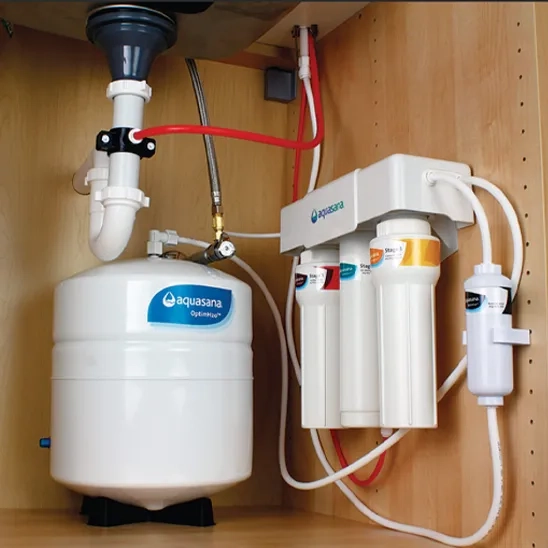
1.7. Certification
Before purchasing an under sink water filter, carefully look for any certification that we are elaborating in this buying guideline. This certification determines which contamination the filters certifies to remove. However, while no federal regulations exist for undersink water filters, purifiers and reverse osmosis systems, voluntary national standards and NSF protocols have been developed that establish minimum requirements for the safety and performance of these products to treat drinking water. The leader in water filtration certification is NSF (National Sanitation Foundation). NSF establishes drinking water standards and also certifies products to meet those standards. Certifications such as NSF/ANSI 42 is for aesthetic improvements (taste, odor) and NSF/ANSI 53 is for health concerns (lead, cysts, pesticides).
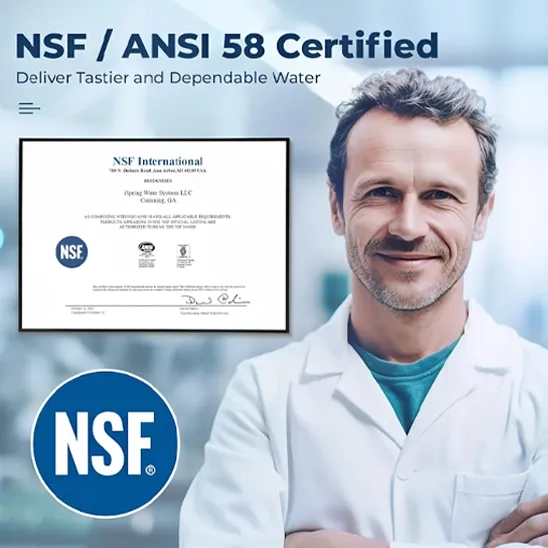
1.8. Cost and Budget
When choosing an under sink water filter, the price of it is important, which can determine your preliminary choices. The price of the self-undersink water filters is influenced by the type of filtration technology , filtration rate, connectivity and any additional features. Basic models with only one filtration stage are the most affordable ones, with a price range from $50 to $200. They offer contaminants like chlorine and sediment. Other price ranges are from $200 to near $600, which offer comprehensive filtration and elimination of multiple contaminants. Also, premium filters that might offer remineralization or smart monitoring may exceed $800. For example, the Waterdrop X8-Basic offers 9 stages of filtration that effectively reduce total dissolved solids (TDS), PFOA, PFOS, chlorine, chloramine, lead, heavy metals and other harmful substances in water. CripsTaste Tankless Reverse Osmosis System features a 8-stage filtration process that removes over 1,000 contaminants, significantly improving your water's taste. 8-Stage Reverse Osmosis System: tankless water purifiers can produce 700 gallons of filtered water per day. The tankless water purifier can produce 700 gallons of filtered water per day, which meets NSF 58&42 standards, ensuring a TDS removal rate of up to 98.2% and a heavy metal reduction rate of up to 99.3%. There are underlying costs for under sink water filters. These filters are typically needed every 6 to 12 months. Therefore, it is vital to consider these costs. Advanced models with multiple-stage filtration offer removal of a range of contaminants, but they have a higher maintenance cost.
1.9. Customer Service
Customer service plays a significant role in enhancing the user experience with under-sink water filters. You wouldn’t want to own a device without ongoing support from the manufacturer, as it could lead to difficulties in use or potential sensor malfunctions. A responsive company ensures customers receive assistance at every step, improving the experience by helping with calibration to boost accuracy and troubleshooting issues such as filter failures. A buying guide can be particularly helpful when choosing a company that offers strong support. More advanced models often require initial setup and configuration, and many companies offer services like free setup assistance. Warranties are also essential, providing protection in case of device failure, with many companies offering free repairs or replacements during the warranty period. Furthermore, good customer support extends beyond the warranty, with easy access to replacement parts when needed. A buying guide can also direct you to companies that offer the best post-warranty support. If issues arise, responsive companies provide live chat, phone, or email support, and some even host online forums or social media groups where users can share their experiences. This is especially helpful, as it allows customers to exchange practical advice about potential device issues.
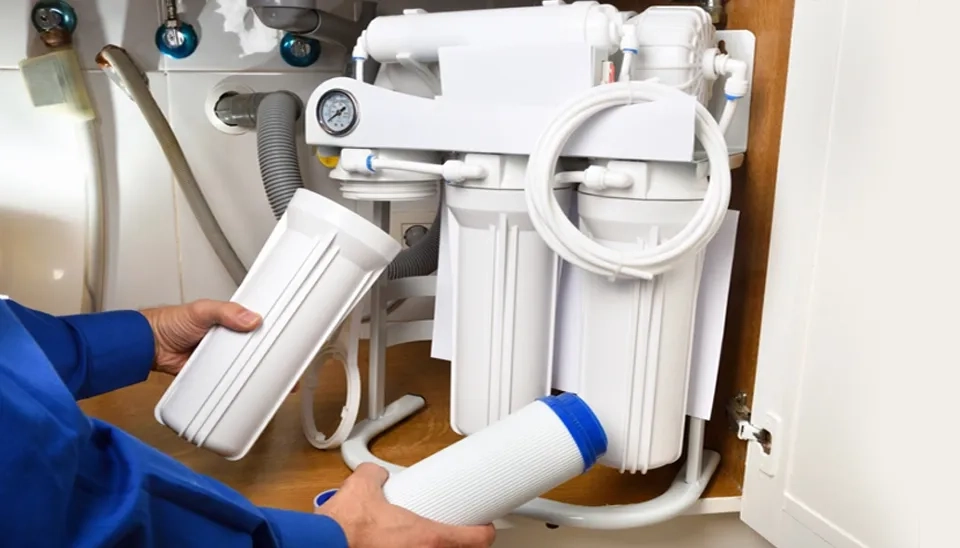
1.10. Product Ranking
An informed decision stems from considering all the criteria that this buying guide is mentioned. Another factor to consider is product ranking. You can get the product ranking by browsing in online platforms , such as Amazon, where you can search for different products and read the reviews and comments of previous users who have experience using the products. Moreover, the article ‘Top 10 Under Sink Water Filters Used for Clean and Pure Drinking Water Production‘ can be beneficial for you. The products in the article can act as your initial choices, subsequently based on other criteria you can add or remove products until reaching the best choice. In this article, ranking of the under sink water filters was done by Bayesian ranking rather than traditional methods. This method uses both average rating and number of total reviews. In the article mentioned above, the iSpring 6-Stage RO Under Sink Water Filter (RCC7AK) ranked first. This under sink water filter consists of an additional 6th stage, which is an Alkaline Remineralization (AK) filter, giving water a more natural taste than a regular 5-stage RO water filter.
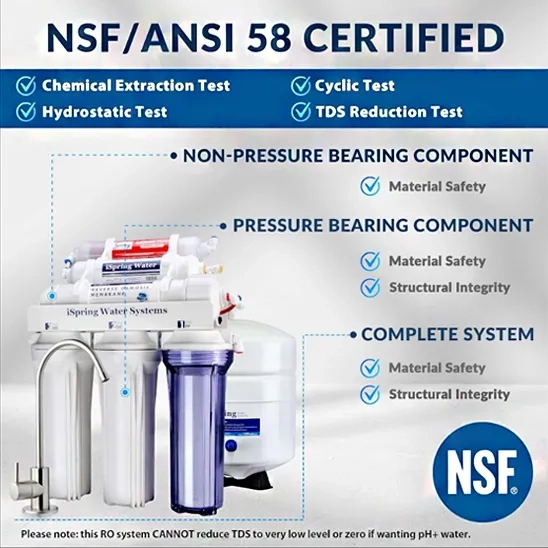
2. Comparing Different Types of Under Sink Water Filters
This buying guide section provides a detailed comparison of different under sink water filters to help you make the right choice. The main categorisation of the undersink water filters is based on their filtration type , tanks and space.
2.1 Filters
The overall types of filters are categorized based on their process and phases of filtration. Activated carbon filters (iSpring RCC7AK) are commonly used for the removal of chlorine, improvement of taste, and removal of odors. However, they do not address microorganisms or nitrates. Ion exchange filters (Waterdrop TSB-ALK 8) work by replacing unwanted ions, like magnesium or calcium, with less unwanted ones, like sodium or potassium, to improve the quality of water. Like activated carbon filters, they are not effective against organic contaminants or microbes. Sediment filters (PUREPLUS Under Sink Water Filter,) use porous walls to filter out substances based on size, so they are effective at removing dirt, rust, and other such larger particles, but are unable to handle dissolved contaminants and can clog up over time. Reverse osmosis (RO) filters (APEC Water Systems ROES-PH75) are extremely effective at removing microorganisms, including parasites, and a wide range of contaminants, but the filters break down over time and require ongoing maintenance. Combination filters, which employ multiple stages of filtration (up to 8), are becoming increasingly popular. These systems address a broader range of contaminants, including chlorine, and are ideal for households with extremely poor water quality. They are costlier to buy initially and take more upkeep than single-stage systems.
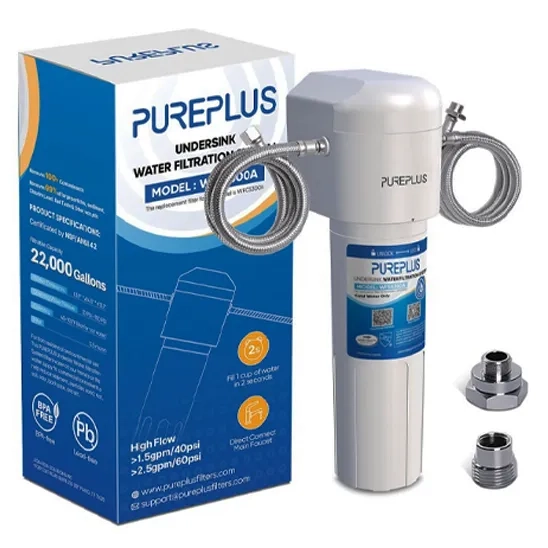
2.2 Tank and Space
When choosing an undersink water filtration system, you will also have to decide between tank or tankless. Tank systems store filtered water in a tank, which is always ready to use when you need it. These are ideal for large families that use more filtered water, but occupy space and require periodic maintenance to prevent water stagnation. Conversely, tankless units filter water as and when required, and hence no storage tank is required. Tankless units are space-saving, and they deliver fresh water round the clock. Nonetheless, they can have lower flow rates and may not be suitable for high-demand households. Tankless systems are also less maintenance-heavy compared to tank systems, which is a convenient option for small space residences or lower water demands.
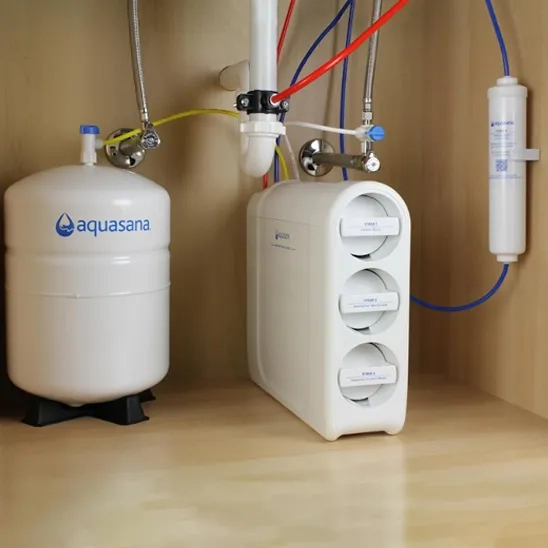
3. Assessing Your Specific Needs Before Purchase
Before purchasing an appropriate undersink water filter, it is vital to evaluate your particular needs to select a device that adequately fulfils your requirements. This includes assessing your requirements and setting a reasonable budget. By following these steps, knowledgeable purchases that match your usage objective can be guaranteed.
3.1. Calculate Your Requirements
First, it’s crucial to calculate the amount of water needed for various uses, such as drinking and cooking. One key factor is the flow rate of the under-sink water filter, which is measured in GPM or liters per minute. For instance, if your household uses 20 liters of water per day, you should select an under-sink filter with a flow rate that matches your consumption needs. A buying guide can help you find the right flow rate for your specific requirements. Additionally, it’s important to identify the types of contaminants you wish to remove based on the quality of your current water. If you need to eliminate a wide range of contaminants, reverse osmosis filters are a great option, as they can remove heavy metals, salts, and microorganisms. Furthermore, understanding how often you’ll need to replace the filters is essential for estimating maintenance costs. Filter replacement schedules depend on the filter type and usage frequency. For example, activated carbon filters may need to be replaced every 6 months (or 1200 gallons), while reverse osmosis filters last up to 12 months, though other components like pre-filters or membranes might require replacement at different intervals. A detailed buying guide will help you understand these maintenance schedules and make an informed decision.
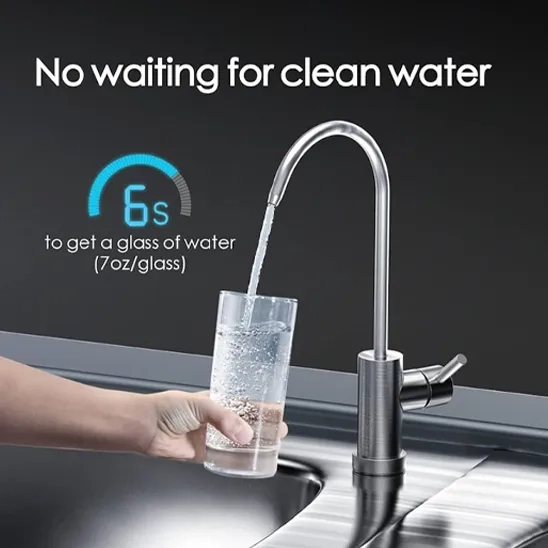
3.2. Set Your Budget
Under sink water filters can have different prices based on the flow rate, filtration stage, capacity and brand and by determining the budget , you can narrow down your options. First class consists of the affordable model with a price under $200. Under sink water filters in this class offer simple filtration with less than 4 stages of filtration. For example, Watts Premier Pure UF-3 offers 3 stages of filtration, including one 5-Micron Sediment Filter for reducing dirt, silt, and rust that affect the taste and appearance of your water; one LVOC Carbon Filter for reducing VOCs; and one 0.1-Micron Hollow-Fiber Semi-Permeable Membrane for blocking sediment and suspended particles. The next price range is the under sink water filters with a price between $200 to $800; these are advanced models with offering up to 8 filtration stages. For example, iSpring RO500AK-BN NSF Certified Tankless with price of $545 is in this category. With its first-stage, a 2-in-1 composite Sediment and Carbon Block filter, second-stage featuring an advanced RO Membrane, the RO500AK-BN effectively removes up to 99% of over 1,000 contaminants, including lead (up to 98% removal), chlorine, fluoride, arsenic, asbestos, calcium, sodium, and more. There are also premium under sink water filters with prices higher than $800, offering a variety of features. For example, Frizzlife RO Reverse Osmosis Water Filtration System with price of $999, features a high-end smart panel, which clearly tells real-time TDS and remaining filter life of each cartridge.
4. Mistakes to Avoid When Choosing Under Sink Water Filters
When choosing an under sink water filter, there are certain key factors that need to be known to avoid any mistakes that this section of the buying guideline discussed. One of the most common mistakes is to overlook the specific contamination in your water because different filters are designed to eliminate specific contamination. Another factor to consider is the maintenance cost because, in some cases, the maintenance cost and initial set-up cost can be more than the initial price of the product. Another important factor to consider is water pressure and filtration rate. Some under sink water filters need a minimum water pressure to work and if the value is lower than the threshold, the product will not work properly. Also, filtration rate is important since some undersink water filters need more time to filter water, which is time-consuming. Although some products come with tanks to store the water and use when it is needed, the tanks can store a limited amount of water. By avoiding these mistakes, an informed decision can be guaranteed. Space limitations are another common mistake to overlook. Some under sink filters, especially models with tanks, require sufficient room for installation. Failing to measure the available space under the sink can result in purchasing a product that doesn’t fit properly or restricts access to plumbing connections.
5. Checklist for Choosing the Best Under Sink Water Filters
Have you identified your main contamination of water (e.g., lead, chemicals, sediments, etc.)?
Have you measured your available sink space?
Have you measured the amount of water consumption in your household?
Have you identified the best filtration technology that suits you ? (e.g. reverse osmosis, activated carbon filters, etc.)
Have you identified the number of filtration stages that suits you ?
Do the undersink water filters provide the technological features you need? (Smart under sink water filters)
Is the device easy to use and simple to set up?
Does the cost correlate with your budget while maintaining the overall requirements and keeping the right balance between expense, features, and durability over time?
Have you looked into the customer service and availability options? (e.g., warranty, professional assistance , return policy, rapid delivery, packaging, free monitoring service and responsiveness)
Have you considered the maintenance costs?
Have you searched product rankings and reviews to ensure reliability? (e.g., Bayesian Rank, buying guides, reviews, comments, etc.)
6. Conclusion
This buying guide line offers a comprehensive guide for buying under sink water filters, encompassing key features like filtration stage, different technology, smart features, certification and filters’ lifespan. This buying guideline is suitable for homeowners that want to select the best under sink water filters for their needs. This guide supports many different types of under sink water filters from affordable ones with a price of under $200 that offer limited contamination removals to advanced and premium ones with a price higher than $800. These models offer a filtration stage up to 9 and remove a range of contamination. However, their maintenance cost can be higher than other models.This buying guide also devoted a section to help users avoid any common mistakes when buying under sink water filters. At the end of the buying guide is a checklist that individuals can use before buying an under sink water filter to make sure to consider every single detail, optimizing their selection. With this extensive buying guide of under sink water filters, users can select a device that not only meets their needs but also adapts to future requirements, ensuring efficient water quality and potentially saving on maintenance and costs.
